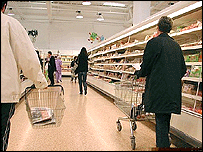
Different food labelling systems have emerged
|
The European Commission has come out in favour of a system of food labelling opposed by the UK regulator.
The commission is proposing it should be mandatory to have guideline daily amounts on the front of packs - a system backed by some UK supermarkets.
But the UK Food Standards Agency favours a traffic light system, where red means fat or sugar levels are high.
Consumer campaigners have criticised the commission's proposal, and said it ignores what works best for the public.
Tesco, Somerfield and Morrison are some of those who use GDAs.
However, companies including Sainsbury's, Waitrose, the Co-Op and Marks and Spencer use the traffic light system, where red signals high levels of fat, salt and sugar.
Asda and McCains use a hybrid of the two.
The UK government has criticised the existence of multiple schemes, and said it would consider legislation if one system is not agreed upon.
'Hindrance'
The commission said the draft regulation was simply setting out general requirements on how nutritional information on calorie content and fat, sugar and salt levels should be displayed.
If approved by EU ministers, the proposal would require that the energy, fat, saturated fat and carbohydrates content of food per 100g or per portion are displayed clearly on the front of the packet.
The labelling would also have to include the proportion of those contents in relation to the recommended daily allowance of each one.
But the commission said there was still scope for each country to promote additional national schemes "provided they do not undermine the EU rules".
 |
 These proposals have ignored what works best for consumers and opted for what works best for some sections of the food industry
These proposals have ignored what works best for consumers and opted for what works best for some sections of the food industry

|
EU Health Commissioner Markos Kyprianou said: "Food labels can have a huge influence on consumers' purchasing decisions.
"Confusing, overloaded or misleading labels can be more of a hindrance than a help to the consumer."
The proposal may also affect online food shopping. In a statement, the commission said: "Many consumers now buy their food via the internet.
"These consumers have the same need for clear, essential information as those who shop in their local supermarket."
''Not far enough'
A Food Standards Agency spokeswoman said it welcomed the commission's recognition of the importance of clear, front of pack labelling.
She added: "An independent evaluation of the three labelling schemes in use in the UK is now underway.
"The results of this study will tell us what is working best for consumers and will inform future negotiations on this EU proposal."
Jane Holdsworth, director of the Food and Drink Federation's GDA campaign said: "We are delighted that the commission is recommending a GDA-based approach to unified food labelling across Europe.
"It recognises that comparing the nutrient content of a foodstuff to a reference intake enables the consumer to better understand the relevance of the information provided on the label for their overall diet."
The Tories also supported the commission's proposal, warning labelling in the UK was currently "confused and inconsistent."
But UK consumer campaigners criticised the proposal.
Which? chief policy adviser, Sue Davies, said: "These proposals have ignored what works best for consumers and opted for what works best for some sections of the food industry."
And Ruairi O'Connor, of the British Heart Foundation said: "We believe the European Commission should have gone a step further and backed mandatory colour coded traffic lights on food labels.
"Research shows that these are more effective than GDA labels in helping people see what's in the food they buy."
Professor Alan Maryon-Davis, of the UK Faculty of Public Health, said: "This is a potential disaster for the health of European consumers.
"The GDA system is too complicated and applies only to adults of average build. But what about everybody else?
"The EU has yet again bowed down to the food industry. We urgently need the much simpler traffic-light system to help us make healthier choices."

~RS~q~RS~~RS~z~RS~59~RS~)
Bookmark with:
What are these?